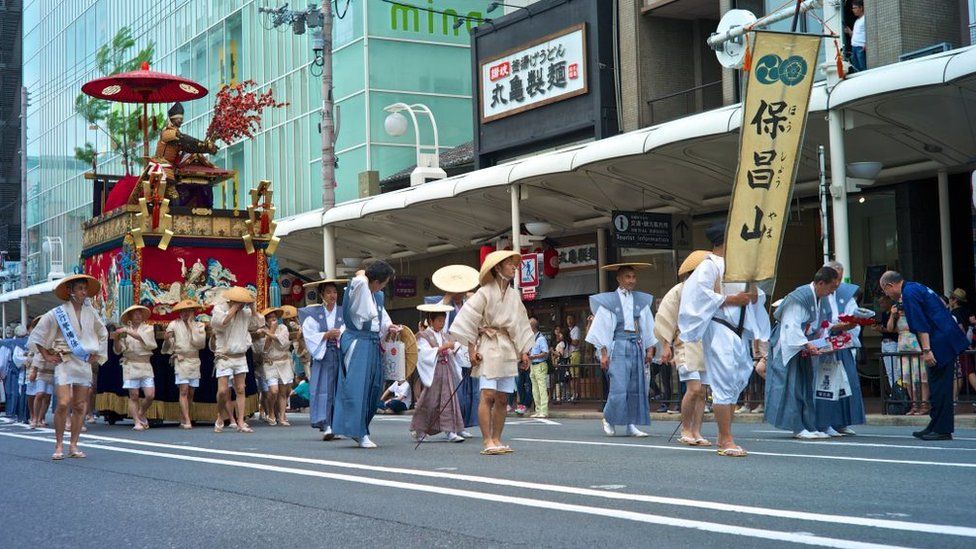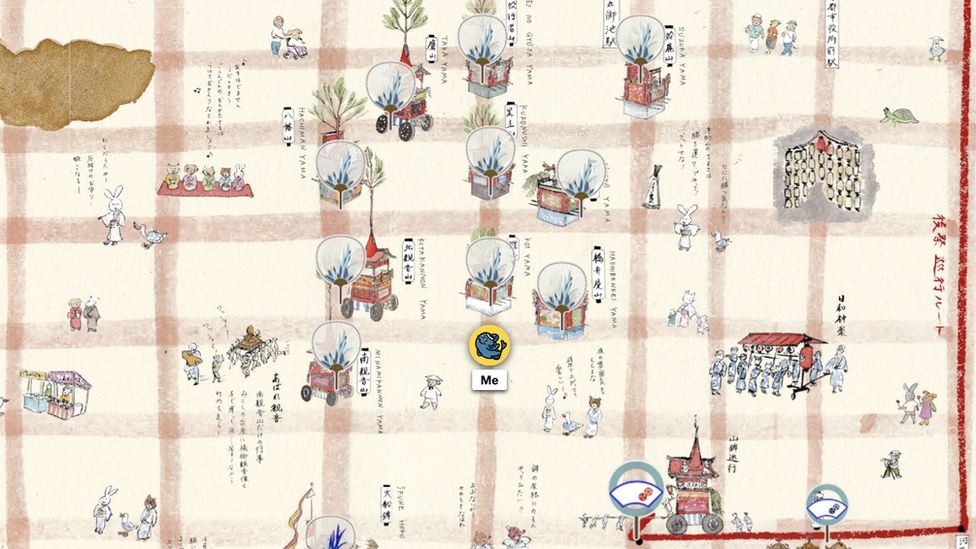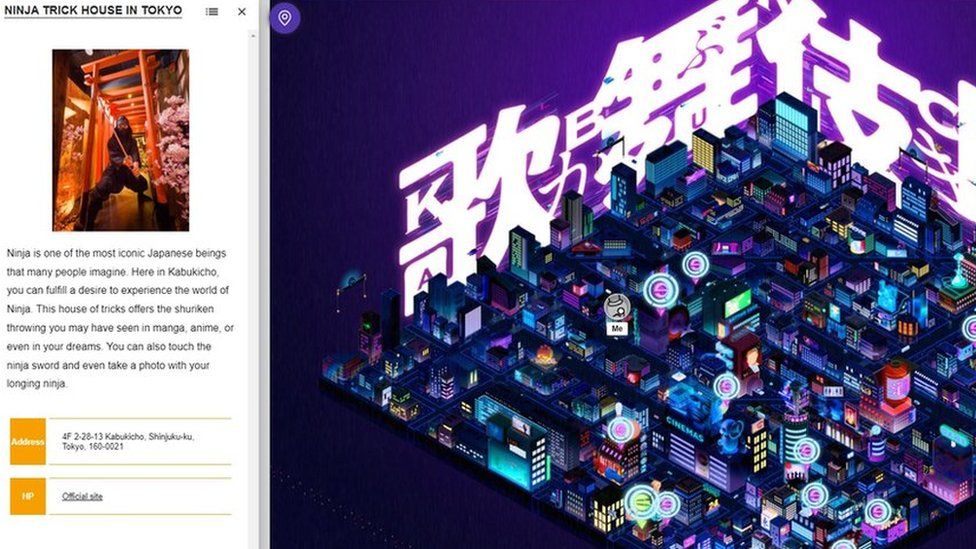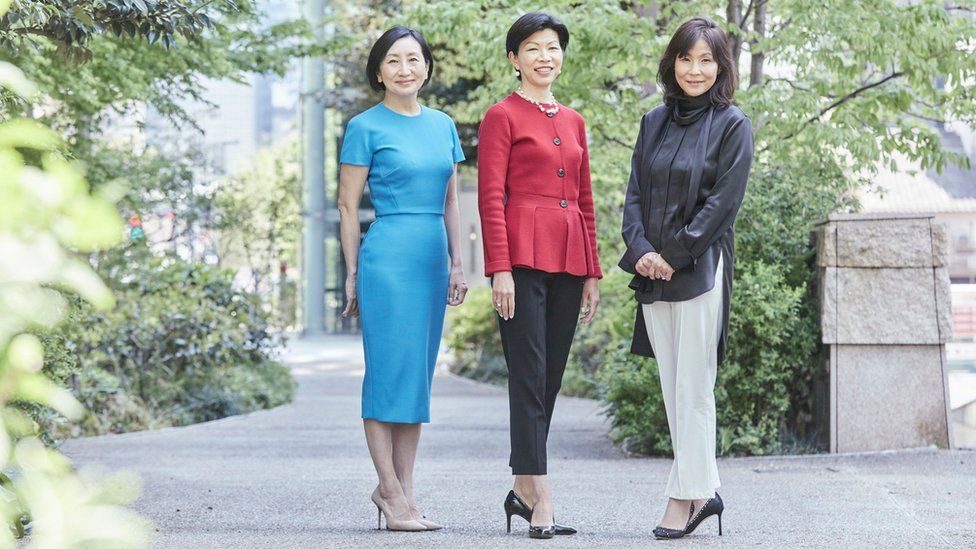Japan’s female bosses mapping a course for other women
 Getty Images
Getty ImagesBelieved to have started in 869AD, the Gion Matsuri is one of the most famous annual festivals in Japan. This year it embraced the digital world.
For the 2022 event back in July, an interactive, online map was made available to show where and when to see the 34 huge, ornate floats that paraded across the city of Kyoto over two separate days.
Using GPS, it showed the location of each float. And you could also use the map to find your friends and chat with them. In addition, if you clicked on a building or street, you could read about its history in Japanese or English.
The person behind the technology is Machi Takahashi, the president and co-chief executive of Kyoto-based, digital map firm Stroly. A mother of two, she is a rare female entrepreneur in a country where the start-up scene is still very much dominated by men.

“I was surprised that [the festival organisers] would let us digitise their map, because I thought these traditional cultural festivals are quite conservative,” she says.
The website-based digital map is accessed by scanning a QR code. Hideo Yoshii, who is in charge of looking after one of the biggest floats, says that Stroly may have gotten some pushback if it had just wanted to put QR code stickers or signs up on walls.
Instead Stroly created a pretty postcard that had not just the QR code printed on it, but also the pattern of a traditional Japanese map. This complemented the atmosphere of the ancient event, and was also used as the design for the digital map Stroly made.
“Before the pandemic, we gave out a pamphlet, but tourists found it difficult to navigate the city,” says a spokeswoman for the city’s tourism department.
“By using Stroly’s digital map, police officers who are on the ground found it much easier to explain to visitors where to go. We’ve also managed to reduce our paper waste by a third,” she adds.

The idea to set up a business making digital maps came to Ms Takahashi and her husband and co-founder Toru while they were both still working at Kyoto-based technology research institute ATR. He is Stroly’s chairman and co-chief executive.
One of their first customers was the movie industry theme park Toei Kyoto Studio Park back in 2010.
“We asked Mr and Ms Takahashi to create a game using Nintendo DS,” says Norihiro Yamaguchi, who was the boss of Toei Kyoto Studio Park at the time.


New Tech Economy is a series exploring how technological innovation is set to shape the new emerging economic landscape.

The map and GPS-based game that the Takahashis produced involved the park’s visitors having to locate seven actors playing screen villains.
Six years later, the Takahashis left the research institute to set up Stroly as their own business, with the theme park remaining one of its main clients.
“Thanks to smartphones which allow users to access the Stroly map in different languages, visitors can find out about the details of our shows and facilities,” says a spokesman for the park.
Stroly has now produced almost 10,000 interactive, digital maps, including one highlighting the vibrant nightlife of the busy Shinjuku area of central Tokyo. That was commissioned by the government of the capital city.

Other maps include where to find the best cheese in the Tokachi dairy farming region of Hokkaido, Japan’s northernmost main island, as well as work for clients outside Japan.
For members of the public Stroly’s maps are free to use. It instead makes its money by charging its customers, mostly in tourism and transport, annual subscriptions.
“When I started thinking about starting my own business in 2015, there was no woman in this information technology field so I had to find my way into this community,” says Ms Takahashi.
“I had to actually contact [US-based Japanese entrepreneur] Ari Horie from Women’s Startup Lab in Silicon Valley, instead of [anyone] in Japan, to help me out.”
Stroly was subsequently selected as one of the first start-ups to be given mentoring by a new regional business support agency called Osaka Innovation Hub.
This was where Ms Takahashi managed to secure funding from Japanese investment bank Daiwa Securities. The firm also later received money from Kyoto City’s start-up fund.
The difficulty faced by female entrepreneurs is not unique to Japan. Even in the US, only 2% of venture capital, which invests in new start-ups, went to women last year.
In an article for Vogue magazine last month where she announced that she was “evolving away from tennis”, US sports star Serena Williams said this was part of the reason she launched her own investment fund, Serena Ventures.

“Sometimes like attracts like,” wrote Williams. “Men are writing those big cheques to one another, and in order for us to change that, more people who look like me need to be in that position, giving money back to themselves.”
Ms Takahashi agrees. “The decision-making roles are also mostly [held by] men. I think they simply cannot relate to the problems and issues addressed by women entrepreneurs,” she says.
The Japanese government had wanted to use the five years from 2015 to 2020 to almost triple the proportion of female managers in the country to reach 30% of the total. However, the current level is just 15%, compared with the global average of 31%.
And according to the country’s Financial Services Agency, less than 1% of Japanese venture capital firms are run by women.
Kathy Matsui leads one such firm, MPower Partners, which she recently started in Tokyo with two female partners, Yumiko Murakami and Seki Miwa. A former vice chair of investment bank Goldman Sachs Japan, Ms Matsui is best known for her “womenomics” drive since the 1990s, which has encouraged the Japanese government to improve its gender ratio among businesses.

“I would say the vast majority of entrepreneurs and founders we’ve met so far, here in Japan, are male,” she says.
“But when we think about start-ups, they’re trying to use innovation to create disruptive businesses, life-changing technologies. And if you’re excluding half the population from your potential talent pool as a start-up, you’re already trying to win a marathon on one leg rather than two.”
Back in Kyoto, Ms Takahashi’s success in finding a gap in the digital tourism market may be an exception to the male-dominated rule. There is no denying that it is still an uphill battle to create a greater equal footing in Japan’s workforce.
So does she have any advice for younger entrepreneurs, and particularly female ones?
“Jump into the ecosystem,” she says. “It is very easy to get to know someone in the field, and once you know somebody, it’s a great network that you need to expand your business.”
